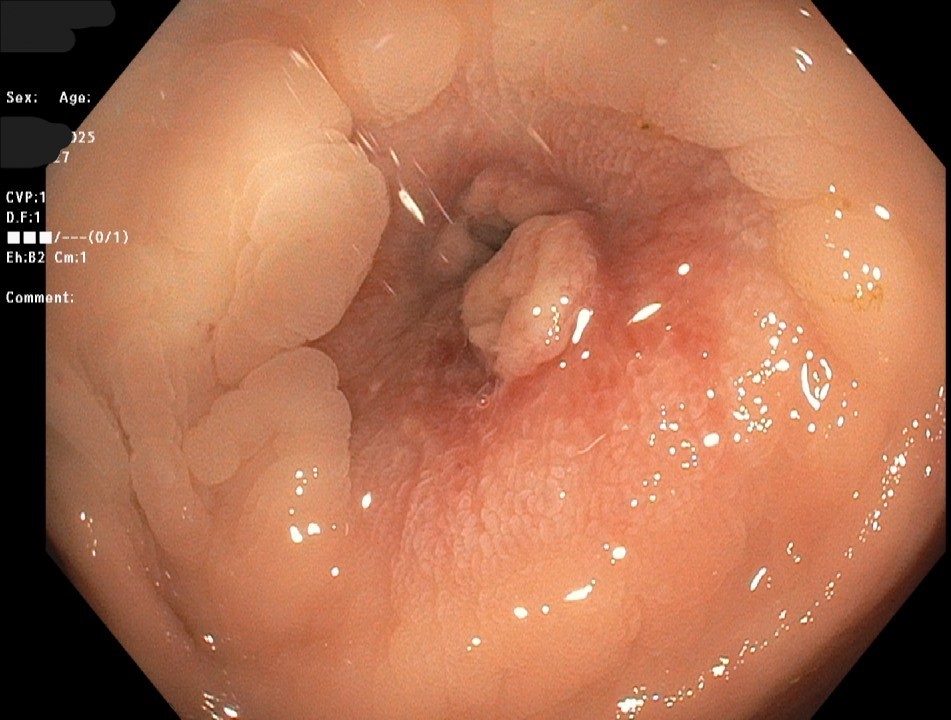Monday Poster Session
Category: Colon
P2527 - Colonic Stricture: A Rare Complication After Selective Therapeutic Embolization for Active Lower Gastrointestinal Bleed
Monday, October 27, 2025
10:30 AM - 4:00 PM PDT
Location: Exhibit Hall

Sinay Ceballos, MD
Aventura Hospital
Aventura, FL
Presenting Author(s)
Sinay Ceballos, MD1, Oscar Hernandez, MD1, Shany Quevedo, MD2, Ramasamy Nathan, MD1
1Aventura Hospital, Aventura, FL; 2Aventura Hospital, Miami, FL
Introduction: The incidence of lower gastrointestinal bleed (LGIB) in the United States is calculated to be around 20 cases per 100,000 individuals. Most cases are secondary to diverticulosis, angiodysplasia and malignancy. In most cases, the bleeding will stop spontaneously, however in about 10-15% of cases further intervention will be needed, either endoscopic or arterial embolization. Selective arterial embolization is a highly effective and safe treatment, but it is not exempt from rare complications. Here we present a patient who developed a colonic stricture after undergoing embolization.
Case Description/
Methods: An 86-years-old male with a history of recurrent lower gastrointestinal bleed secondary to colonic angiodysplasia, status post previous successful endoscopic therapy and anticoagulation use, presented with a new episode of severe lower gastrointestinal bleed. A CT angiography of the abdomen and pelvis showed active contrast extravasation in the cecum. He underwent selective arterial embolization of distal branches of the ileocolonic artery. The bleeding was successfully controlled; however, over the following months the patient developed recurrent episodes of abdominal pain, nausea and vomiting consistent with a partial bowel obstruction. After imaging and endoscopic studies were done a colonic stricture was found in the ascending colon (Fig. 1), suspected to be secondary to ischemia. The patient underwent a right colectomy (Fig. 2) with ileocolonic anastomosis and had an uneventful post-surgical clinical course.
Discussion: The management of lower gastrointestinal bleed (LGIB) involves supportive management, endoscopic interventions with both diagnostic and therapeutic purposes and in some cases selective arterial embolization is needed. This is a very effective and generally considered safe intervention, with very few complications. Among these complications, the development of a bowel stricture is particularly rare and it is thought to result from ischemia, inflammation and eventual tissue fibrosis. We hope to assist other clinicians during the process of making the appropriate diagnosis and proceeding with the indicated interventions when presented with similar clinical scenarios.

Figure: Fig. 1. Endoscopic view of the stricture in the ascending colon

Figure: Fig. 2. Right colon after surgical resection: area of narrowing with previously placed Endoclip
Disclosures:
Sinay Ceballos indicated no relevant financial relationships.
Oscar Hernandez indicated no relevant financial relationships.
Shany Quevedo indicated no relevant financial relationships.
Ramasamy Nathan indicated no relevant financial relationships.
Sinay Ceballos, MD1, Oscar Hernandez, MD1, Shany Quevedo, MD2, Ramasamy Nathan, MD1. P2527 - Colonic Stricture: A Rare Complication After Selective Therapeutic Embolization for Active Lower Gastrointestinal Bleed, ACG 2025 Annual Scientific Meeting Abstracts. Phoenix, AZ: American College of Gastroenterology.
1Aventura Hospital, Aventura, FL; 2Aventura Hospital, Miami, FL
Introduction: The incidence of lower gastrointestinal bleed (LGIB) in the United States is calculated to be around 20 cases per 100,000 individuals. Most cases are secondary to diverticulosis, angiodysplasia and malignancy. In most cases, the bleeding will stop spontaneously, however in about 10-15% of cases further intervention will be needed, either endoscopic or arterial embolization. Selective arterial embolization is a highly effective and safe treatment, but it is not exempt from rare complications. Here we present a patient who developed a colonic stricture after undergoing embolization.
Case Description/
Methods: An 86-years-old male with a history of recurrent lower gastrointestinal bleed secondary to colonic angiodysplasia, status post previous successful endoscopic therapy and anticoagulation use, presented with a new episode of severe lower gastrointestinal bleed. A CT angiography of the abdomen and pelvis showed active contrast extravasation in the cecum. He underwent selective arterial embolization of distal branches of the ileocolonic artery. The bleeding was successfully controlled; however, over the following months the patient developed recurrent episodes of abdominal pain, nausea and vomiting consistent with a partial bowel obstruction. After imaging and endoscopic studies were done a colonic stricture was found in the ascending colon (Fig. 1), suspected to be secondary to ischemia. The patient underwent a right colectomy (Fig. 2) with ileocolonic anastomosis and had an uneventful post-surgical clinical course.
Discussion: The management of lower gastrointestinal bleed (LGIB) involves supportive management, endoscopic interventions with both diagnostic and therapeutic purposes and in some cases selective arterial embolization is needed. This is a very effective and generally considered safe intervention, with very few complications. Among these complications, the development of a bowel stricture is particularly rare and it is thought to result from ischemia, inflammation and eventual tissue fibrosis. We hope to assist other clinicians during the process of making the appropriate diagnosis and proceeding with the indicated interventions when presented with similar clinical scenarios.

Figure: Fig. 1. Endoscopic view of the stricture in the ascending colon

Figure: Fig. 2. Right colon after surgical resection: area of narrowing with previously placed Endoclip
Disclosures:
Sinay Ceballos indicated no relevant financial relationships.
Oscar Hernandez indicated no relevant financial relationships.
Shany Quevedo indicated no relevant financial relationships.
Ramasamy Nathan indicated no relevant financial relationships.
Sinay Ceballos, MD1, Oscar Hernandez, MD1, Shany Quevedo, MD2, Ramasamy Nathan, MD1. P2527 - Colonic Stricture: A Rare Complication After Selective Therapeutic Embolization for Active Lower Gastrointestinal Bleed, ACG 2025 Annual Scientific Meeting Abstracts. Phoenix, AZ: American College of Gastroenterology.
